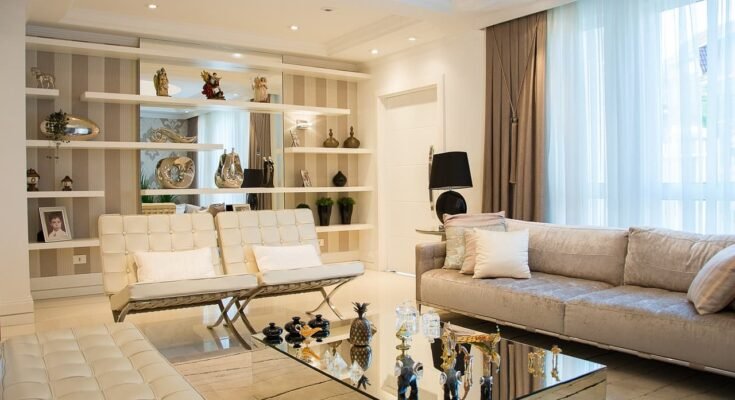Introduction
Designing a living room that is both functional and stylish requires careful consideration of space. Understanding the standard dimensions for living rooms can help you create a layout that maximizes comfort and aesthetics.
In this article, we’ll explore the typical dimensions for various aspects of living rooms, provide design tips, and answer frequently asked questions to guide you in creating your ideal space.
Understanding Standard Living Room Dimensions
When planning your living room, it’s crucial to start with standard dimensions to ensure a harmonious design.
1. Average Living Room Size
The size of a living room can vary significantly depending on the home’s design and location. However, in many homes, the Standard Dimensions For Living Rooms fall within these ranges:
- Small Living Rooms: Typically 10×12 feet (3×3.6 meters)
- Medium Living Rooms: Around 15×20 feet (4.6×6 meters)
- Large Living Rooms: Often 20×25 feet (6×7.6 meters) or more
These dimensions provide a starting point, but remember that the ideal size for your living room will depend on your needs and preferences.Standard Dimensions for Living Rooms
2. Furniture Arrangement
Effective furniture arrangement is key to creating a functional living room. Here are some standard dimensions for common furniture pieces:
- Sofa: Usually 6 to 8 feet (1.8 to 2.4 meters) long and 3 to 4 feet (0.9 to 1.2 meters) deep.
- Coffee Table: Typically 1.5 to 2 feet (0.45 to 0.6 meters) in height, and 3 to 4 feet (0.9 to 1.2 meters) in length.
- TV Stand: Commonly 4 to 6 feet (1.2 to 1.8 meters) long and 1.5 to 2 feet (0.45 to 0.6 meters) deep.
3. Seating Arrangement
Allow for adequate space around seating to ensure comfort and accessibility. Standard Dimensions For Living Rooms recommendations include:
- Between Sofa and Coffee Table: 18 inches (45 cm)
- Between Seating Areas: 24 to 30 inches (60 to 75 cm)
- Pathways: At least 30 to 36 inches (75 to 90 cm) wide

Designing Your Living Room Layout
Once you have a grasp of standard dimensions, the next step is to design a layout that fits your space. Here are some tips:
1. Create Zones
Divide your living room into functional zones, such as a seating area, entertainment zone, and reading nook. Use furniture and rugs to define these areas clearly.
2. Optimize Traffic Flow
Ensure that pathways are clear and allow for easy movement. Avoid placing large furniture pieces in high-traffic areas to prevent congestion.
3. Use Multi-Functional Furniture
In smaller living rooms, opt for multi-functional furniture like sofa beds or storage ottomans to maximize space usage.Standard Dimensions For Living Rooms
4. Balance Proportions
Balance larger furniture pieces with smaller ones to avoid overwhelming the space. For example, pair a large sofa with a couple of smaller armchairs.
Frequently Asked Questions (FAQ)
Q1: How do I measure my living room accurately?
A1: To measure your living room, use a tape measure to find the length and width of the room. Record these measurements and consider the placement of doors, windows, and any architectural features that may affect the layout.
Q2: What should I do if my living room is an unusual shape?
A2: For irregularly shaped rooms, use modular or flexible furniture that can adapt to the space. Consider creating zones to make the room feel more organized and functional.
Q3: How can I make a small living room feel larger?
A3: Use light colors for walls and furniture to create a sense of openness. Incorporate mirrors to reflect light and use multi-functional furniture to maximize space.
Q4: What is the best way to arrange furniture in a large living room?
A4: In a large living room, create distinct areas for different activities. Arrange furniture to foster conversation and use rugs to define spaces. Ensure there is a good balance between open areas and furniture placement.
Q5: How can I add style to my living room without compromising space?
A5: Incorporate stylish accessories such as throw pillows, artwork, and decorative lighting. Choose furniture with sleek lines and consider built-in storage solutions to keep the room looking tidy and stylish.
Conclusion
Understanding and applying standard dimensions for living rooms is essential for creating a space that is both functional and stylish. Standard Dimensions for Living Rooms
By following these guidelines and design tips, you can make Standard Dimensions For Living Rooms the most of your living area and ensure it meets your needs and preferences.
Whether you’re decorating a small apartment or a spacious home, the right measurements and thoughtful design will help you achieve a beautiful and comfortable living room.



